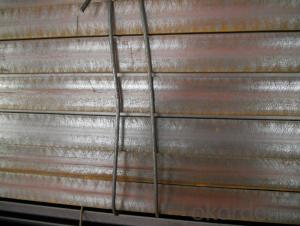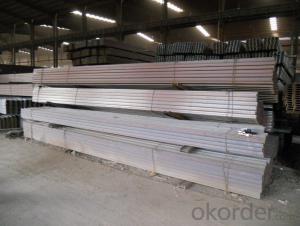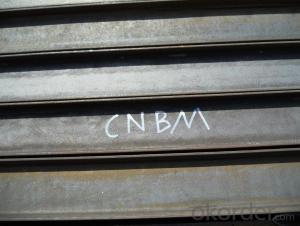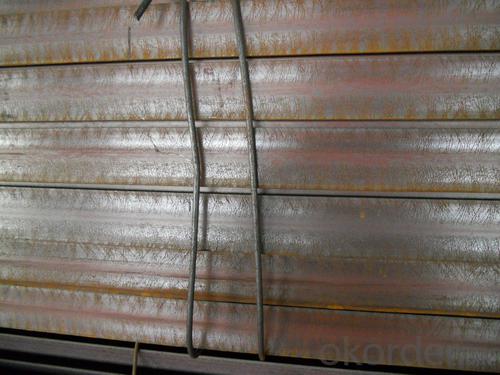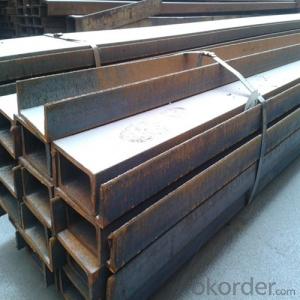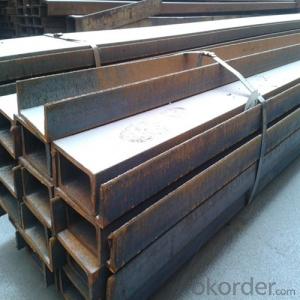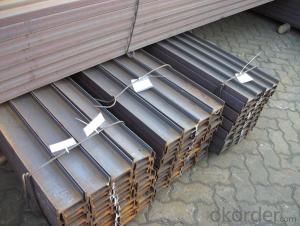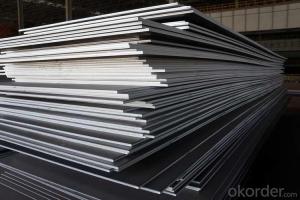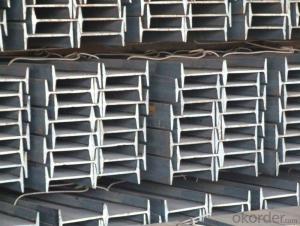Hot rolled stainless steel I-Beam for construction
- Loading Port:
- Tianjin
- Payment Terms:
- TT or LC
- Min Order Qty:
- 25 m.t.
- Supply Capability:
- 100000 m.t./month
OKorder Service Pledge
OKorder Financial Service
You Might Also Like
Hot rolled stainless steel I-Beam for constructionProduct Description:
OKorder is offering Hot rolled stainless steel I-Beam for construction at great prices with worldwide shipping. Our supplier is a world-class manufacturer of steel, with our products utilized the world over. OKorder annually supplies products to European, North American and Asian markets. We provide quotations within 24 hours of receiving an inquiry and guarantee competitive prices.
Product Applications:
Hot rolled stainless steel I-Beam are ideal for structural applications and are widely used in the construction of buildings and bridges, and the manufacturing, petrochemical, and transportation industries.
Product Advantages:
OKorder's Steel I-Beam for construction are durable, strong, and resist corrosion.
Main Product Features:
· Premium quality
· Prompt delivery & seaworthy packing (30 days after receiving deposit)
· Corrosion resistance
· Can be recycled and reused
· Mill test certification
· Professional Service
· Competitive pricing
Product Specifications:
Applications of IPEAA Beam
1. structure construction and electronic tower building construction
2. bridge, trestle, autos, brackets, machinery
3.It is widely used in various building structures and engineering structures such as roof beams, bridges, transmission towers, hoisting machinery and transport machinery, ships, industrial furnaces, reaction tower, container frame and warehouse etc.
Package & Delivery Terms of IPEAA Beam
1. Packing: it is nude packed in bundles by steel wire rod
2. Bundle weight: not more than 3.5MT for bulk vessel; less than 3 MT for container load
3. Marks:
Color marking: There will be color marking on both end of the bundle for the cargo delivered by bulk vessel. That makes it easily to distinguish at the destination port.
Tag mark: there will be tag mark tied up on the bundles. The information usually including supplier logo and name, product name, made in China, shipping marks and other information request by the customer.
If loading by container the marking is not needed, but we will prepare it as customer request.
4. All the IPEAA Beams will be delivered to the port of Tianjin within 45 days after receiving the Original L/C at sight or the advance payment by T/T.
5. Transportation: the goods are delivered by truck from mill to loading port, the maximum quantity can be loaded is around 40MTs by each truck. If the order quantity cannot reach the full truck loaded, the transportation cost per ton will be little higher than full load.
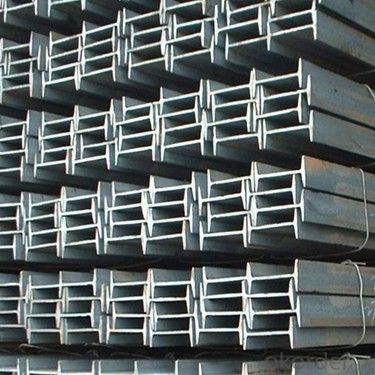
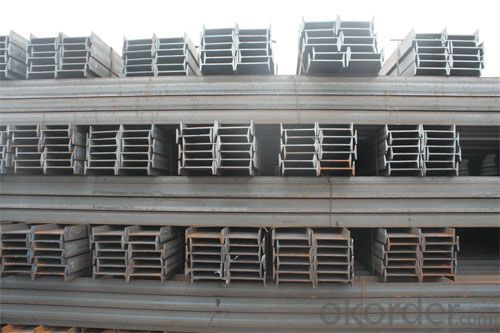
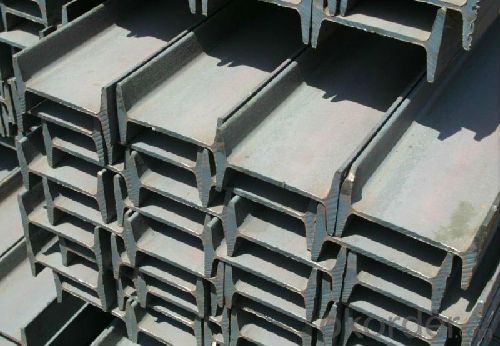
FAQ:
Q1: What makes stainless steel stainless?
A1: Stainless steel must contain at least 10.5 % chromium. It is this element that reacts with the oxygen in the air to form a complex chrome-oxide surface layer that is invisible but strong enough to prevent further oxygen from "staining" (rusting) the surface. Higher levels of chromium and the addition of other alloying elements such as nickel and molybdenum enhance this surface layer and improve the corrosion resistance of the stainless material.
Q2: Can stainless steel rust?
A2: Stainless does not "rust" as you think of regular steel rusting with a red oxide on the surface that flakes off. If you see red rust it is probably due to some iron particles that have contaminated the surface of the stainless steel and it is these iron particles that are rusting. Look at the source of the rusting and see if you can remove it from the surface.
- Q: How do you calculate the torsional deflection of a steel I-beam?
- To calculate the torsional deflection of a steel I-beam, you need to consider the beam's cross-sectional properties, such as its moment of inertia, torsional constant, and length. By applying the torsion equation, which relates the applied torque, the polar moment of inertia, and the length of the beam, you can determine the torsional deflection at a given point along the beam.
- Q: How do you calculate the shear force in steel I-beams?
- In order to determine the shear force in steel I-beams, one must take into account the applied load and the beam's cross-sectional properties. The shear force pertains to the internal force that acts parallel to the beam's cross-section and has a tendency to shear the material. The calculation involves finding the maximum shear force at any given point along the beam's length. One commonly used method is the shear force diagram, which is a graphical representation of the distribution of shear force. This diagram aids in identifying the points of maximum shear and determining their corresponding magnitudes. To create a shear force diagram, the first step is to analyze the applied loads and their positions along the beam. This includes considering both point loads and distributed loads acting on the beam. The distribution of these loads along the beam's length is then determined, taking into account any reactions or supports at the ends. Next, the internal shear force at different points on the beam is calculated. This is accomplished by summing up the vertical forces acting on either side of the selected point. The total of these forces provides the magnitude and direction of the shear force at that specific location. This process is repeated at regular intervals along the beam's length to generate a shear force diagram. The diagram typically displays the shear force values plotted against the beam's length or position along the x-axis. It often indicates the points of maximum shear force, which are crucial in designing the beam to withstand these forces without failure. It is important to note that calculating the shear force in steel I-beams necessitates knowledge of the beam's properties, such as its moment of inertia and cross-sectional dimensions. These properties can be determined from the beam's specifications or by physically measuring the beam. In conclusion, calculating the shear force in steel I-beams involves analyzing the applied loads, determining their distribution along the beam, and calculating the internal shear forces at various points. This information is then used to create a shear force diagram, which assists in designing the beam to withstand these forces.
- Q: What are the common loadings and forces that steel I-beams need to withstand?
- Steel I-beams are commonly used in construction and engineering projects due to their strength and load-bearing capabilities. They are designed to withstand various loads and forces to ensure the stability and integrity of the structure they are supporting. Some of the common loadings and forces that steel I-beams need to withstand include: 1. Dead Load: This refers to the weight of the structure itself, including the weight of the steel beam and any other permanent materials or components. Steel I-beams are designed to bear the dead load without experiencing excessive deflection or deformation. 2. Live Load: Live loads are temporary loads that can vary in magnitude and location. Examples include people, furniture, equipment, and vehicles. Steel I-beams are engineered to support these dynamic loads and distribute them evenly to prevent overloading. 3. Wind Load: Buildings and structures are subjected to wind forces, which can exert significant pressure on the steel I-beams. The design of I-beams considers wind speed, building height, and the shape of the structure to ensure they can withstand these lateral forces without failure. 4. Snow Load: In areas with heavy snowfall, steel I-beams must be able to withstand the weight of accumulated snow on the roof or other horizontal surfaces. The design takes into account the estimated weight of snow and distributes it across the beam to avoid excessive deflection or collapse. 5. Seismic Load: Earthquakes generate powerful seismic forces that can cause significant structural damage if not properly accounted for. Steel I-beams are designed to withstand these forces by incorporating seismic-resistant features such as high-strength connections and bracing systems. 6. Impact Load: In certain applications, steel I-beams may need to withstand impact forces, such as those caused by falling objects or collisions. These beams are designed with additional reinforcement to absorb and distribute the impact energy, preventing structural failure. 7. Temperature Load: Steel expands and contracts with temperature fluctuations. Steel I-beams must be able to handle thermal expansion and contraction to avoid stress-induced failures. Additionally, they may be exposed to high temperatures in industrial settings, which require special consideration in their design. Overall, steel I-beams are engineered to withstand a wide range of loadings and forces, ensuring the structural stability and safety of the buildings and structures they support.
- Q: What are the different factors that affect the strength of steel I-beams?
- There are several factors that affect the strength of steel I-beams. 1. Material composition: The type of steel used and its chemical composition greatly influence the strength of the I-beam. Higher carbon content generally results in increased strength, while other alloying elements such as manganese, silicon, and nickel can also impact the strength properties. 2. Cross-sectional shape: The shape of the I-beam's cross-section plays a significant role in its strength. The flange width, flange thickness, and web thickness all contribute to the overall strength of the beam. Generally, wider flanges and thicker web sections result in greater strength. 3. Moment of inertia: The moment of inertia, which is a measure of an object's resistance to changes in rotation, affects the beam's strength. A higher moment of inertia indicates a greater resistance to bending, thus increasing the beam's strength. 4. Length and unsupported span: The length of the I-beam and the unsupported span it needs to cover can impact its strength. Longer beams and larger unsupported spans may require additional support or reinforcement to maintain their strength. 5. Load distribution: The way the load is distributed along the length of the beam affects its strength. Concentrated loads and point loads exert more stress on specific areas, potentially leading to localized failure. Uniformly distributed loads are generally more favorable for maintaining the beam's strength. 6. Temperature: Steel's strength can be affected by changes in temperature. At high temperatures, steel can experience thermal expansion and softening, leading to reduced strength. Conversely, extremely low temperatures can cause brittleness, making the steel more susceptible to fracture. 7. Manufacturing and fabrication processes: The quality of the manufacturing and fabrication processes employed can influence the strength of the I-beam. Proper welding, heat treatment, and post-processing can enhance the structural integrity and strength of the beam. 8. Corrosion and environmental factors: The presence of corrosive agents, such as moisture or chemicals, can weaken the steel over time. Proper protective coatings and regular maintenance are essential to prevent corrosion and preserve the beam's strength. It is important to consider these factors when designing and selecting steel I-beams for various applications to ensure optimal strength and structural integrity.
- Q: How do steel I-beams contribute to the overall stability of a structure?
- Enhancing the overall stability of a structure is a crucial role played by steel I-beams. These beams are specifically engineered to carry and distribute the building's load across its length, thereby preventing stress concentration in specific areas. The distinctive shape of an I-beam, with its flanges and web, grants it exceptional strength and resistance against bending or twisting forces. A significant contribution made by steel I-beams towards stability is providing structural support and minimizing the risk of building collapse. The horizontal flanges of the I-beam aid in evenly distributing the structure's weight, enabling it to bear substantial loads, including the building's own weight and additional live loads like furniture, equipment, or people. This distribution of load ensures stability and reduces the chance of catastrophic failure. Furthermore, steel I-beams effectively resist both vertical and horizontal forces, such as wind or seismic loads. The robust and rigid nature of steel allows these beams to transmit these forces through the structure, preventing excessive deflection or deformation. By withstanding these external forces, I-beams preserve the integrity of the structure, safeguarding it against potential damage or collapse. An additional advantage of steel I-beams lies in their ability to span long distances without requiring intermediate supports. These beams can be fabricated to span significant distances, eliminating the need for additional columns or walls. This grants more design flexibility and utilization of space, enabling open floor plans and maximizing the usable area of the structure. Moreover, steel I-beams are highly durable and possess a high strength-to-weight ratio. This means they can withstand heavy loads while being relatively lightweight compared to other construction materials. This advantage simplifies the construction process, reduces the overall weight of the structure, and leads to cost savings and increased design adaptability. In conclusion, steel I-beams contribute to the overall stability of a structure through structural support, load distribution, resistance against external forces, long-span capabilities, and durability. Their unique design and material properties establish them as indispensable components for ensuring the safety and stability of buildings in various applications, ranging from residential homes to large-scale commercial or industrial structures.
- Q: How much is the load-bearing capacity of No. 10 I-beam per metre?
- No problem. Generally, the wardrobe is 550-650 millimeters deep. Two are enough.
- Q: How do you calculate the shear force in a steel I-beam?
- In order to determine the shear force in a steel I-beam, it is necessary to take into account both the applied loads and the structural properties of the beam. The shear force is an internal force that acts parallel to the longitudinal axis of the beam and can cause deformation or failure. To calculate the shear force, the first step is to identify the external loads acting on the beam, such as point loads, distributed loads, or moments. These loads can be determined through the design or analysis of the structure or by considering the application of the beam. Once the external loads are known, the distribution of these loads over the length of the beam must be analyzed. This involves determining the position and magnitude of the loads at different points along the beam. For example, for a uniformly distributed load, the load per unit length needs to be determined. Next, it is important to determine the support conditions of the beam, whether it is simply supported or fixed at both ends. This information is crucial as it affects the calculations of the reactions at the supports, which in turn influence the shear force. After determining the load distribution and support conditions, the shear force at any given point along the beam can be calculated. This requires considering the equilibrium of forces at that specific point. At any section of the beam, the sum of the vertical forces must be zero. By taking into account the external loads and reactions at the supports, the shear force at that specific section can be calculated. This can be done using the method of sections or by calculating the change in shear force between neighboring sections. Additionally, it is important to consider the structural properties of the steel I-beam, such as its moment of inertia and the distance from the neutral axis to the extreme fibers. These properties affect the distribution of shear force within the beam and must be considered during the calculations. In conclusion, calculating the shear force in a steel I-beam requires a comprehensive analysis of the external loads, support conditions, and structural properties. By applying the principles of equilibrium and considering the specific characteristics of the beam, an accurate determination of the shear force at any point along the beam can be made.
- Q: What are the load-bearing capacities of steel I-beams?
- The load-bearing capacities of steel I-beams vary depending on several factors, including the size and shape of the beam, the type of steel used, and the specific design and construction of the structure in which the beam is being used. Steel I-beams are widely used in construction and are known for their strength and durability. They are designed to carry heavy loads and distribute them evenly along the length of the beam. The load-bearing capacity of a steel I-beam is primarily determined by its moment of inertia, which is a measure of the beam's resistance to bending. The moment of inertia is influenced by the dimensions of the beam's cross-section, such as the height and width of the flanges and the thickness of the web. To determine the load-bearing capacity of a specific steel I-beam, engineers use various calculations and formulas based on structural engineering principles. These calculations take into account factors such as the material properties of the steel, the design specifications of the beam, and the applied loads that the beam will be subjected to. The load-bearing capacity is typically expressed in terms of a maximum allowable load or a maximum allowable stress that the beam can safely support without failure. It is important to note that load-bearing capacities can vary significantly depending on the specific application and design requirements. Therefore, it is crucial to consult the appropriate building codes, engineering standards, and structural design guidelines to ensure the proper selection and installation of steel I-beams for a particular project. Consulting with a qualified structural engineer or a professional in the field of construction is highly recommended to accurately determine the load-bearing capacities of steel I-beams in a specific context.
- Q: What are the common challenges involved in working with steel I-beams?
- When dealing with steel I-beams, there are several challenges that one may encounter. One of the most common challenges is their weight and size. Steel I-beams are heavy and often require specialized equipment and machinery for transportation and installation, leading to logistical difficulties and increased project costs. Another challenge is their lack of flexibility. Although steel I-beams are known for their strength and durability, this rigidity can make it difficult to accommodate changes or modifications during construction. Any alterations may necessitate cutting, welding, or additional reinforcements, which can be time-consuming and expensive. Maintaining the structural integrity of steel I-beams is also a challenge. They are prone to corrosion, especially in high humidity or chemical-exposed environments. To prevent rust and ensure long-lasting durability, proper coating and regular maintenance are essential. Furthermore, the installation of steel I-beams often requires precise measurement and alignment to ensure proper load distribution and structural stability. Any inaccuracies or errors in measurement can result in structural issues or safety hazards. Fire resistance poses another challenge. Although steel I-beams have a high melting point, prolonged exposure to high temperatures can weaken their structural integrity. To mitigate this risk, fire-resistant coatings or additional fire protection measures are often necessary. Lastly, cost can be a significant challenge when working with steel I-beams. Steel is generally more expensive than other building materials, so budget constraints may limit their use in construction projects. Moreover, the fluctuating prices of steel can impact project budgets and timelines. In conclusion, while steel I-beams offer numerous advantages such as strength and durability, they also present challenges related to weight, rigidity, maintenance, alignment, fire resistance, and cost. Overcoming these challenges requires careful planning, expertise, and adherence to industry standards and best practices.
- Q: Can steel I-beams be used in the construction of office buildings?
- Yes, steel I-beams can be used in the construction of office buildings. Steel I-beams are commonly used as structural support elements in various types of buildings, including office buildings. They are known for their strength, durability, and load-bearing capacity, making them suitable for supporting the weight of the floors, walls, and roof of an office building. Steel I-beams are often used in the construction of skyscrapers, where their ability to withstand heavy loads and provide long-span support is crucial. Additionally, steel I-beams offer flexibility in design and can be easily integrated into the overall architectural layout of an office building. Their use in construction also allows for faster construction times and reduced costs compared to other structural materials. Overall, steel I-beams are a popular choice in the construction of office buildings due to their strength, reliability, and versatility.
Send your message to us
Hot rolled stainless steel I-Beam for construction
- Loading Port:
- Tianjin
- Payment Terms:
- TT or LC
- Min Order Qty:
- 25 m.t.
- Supply Capability:
- 100000 m.t./month
OKorder Service Pledge
OKorder Financial Service
Similar products
Hot products
Hot Searches
Related keywords
